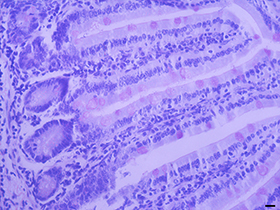Periodic Acid-Schiff Staining Kit |
| Catalog No.GC26376 |
Periodic Acid-Schiff Staining Kit (PAS Staining Kit) employs periodic acid solution and Schiff reagent to stain glycogen, mucopolysaccharide and fungi present in paraffin sections, frozen sections, cultured cells, blood smears, and bone marrow smears, etc.
Products are for research use only. Not for human use. We do not sell to patients.

Sample solution is provided at 25 µL, 10mM.
GLPBIO's Periodic Acid-Schiff Staining Kit (PAS Staining Kit) employs periodic acid solution and Schiff reagent to stain glycogen, mucopolysaccharide and fungi present in paraffin sections, frozen sections, cultured cells, blood smears, and bone marrow smears, etc.
PAS staining is also named as glycogen staining because it is mainly used for the staining of polysaccharides such as glycogen, and mucosubstances such as glycosaminoglycan, mucins, glycoproteins and glycolipids. PAS staining is a widely used in pathology. It not only stains neutral mucosubstances, but also some acidic substances including cartilage, pituitary, fungi, pigments, amyloid, and basement membrane, etc. In addition, PAS staining is often used in the diagnosis of auxiliary lymphocytic leukemia in clinical.
Glycogen is a macromolecular polysaccharide compound composed of D-glucose. The synthesis and catabolism of glycogen mainly occur in liver, kidney and muscle tissues. Periodic acid is a strong oxidant which oxidizes the 1,2-ethylene glycol group (CHOH-CHOH) of glycogen into two free aldehyde groups (-CHO). Schiff reagent contains basic fuchsin and sulfurous acid. After combination with sulfurous acid, basic fuchsin loses its quinone structure and turns colorless. However, the quinone structure of the colorless basic fuchsin can be restored by the free aldehyde groups generated from the periodic acid reaction, and stains cytoplasm in magenta. The color intensity of magenta is proportional to the content of polysaccharide.
|
Samples |
Color |
|
PAS Positive Material |
Magenta |
|
Fungal Organisms |
Magenta |
|
Nuclei |
Blue |
|
Background |
Light Purple |
As monosaccharides are removed during histochemistry procedures such as fixation, dehydration, and embedding, the saccharides exhibited on tissue sections after PAS staining are mainly glycogen and other polysaccharides. When necessary, set up a control to determine whether the magenta substance is glycogen by treating samples with amylase prior to PAS staining. The absence of magenta substances in control indicates the magenta substance in samples is indeed glycogen because glycogen is hydrolyzed by amylase, otherwise it is other polysaccharides.
This kit provides all reagents required for the PAS staining, except ethanol solutions.
The kit is simple and convenient to use, producing stable and strong staining results. Please see Figure 1 for the staining result of mouse small intestine in paraffin sections with the PAS Staining Kit.

Store kit at 4℃ for up to one year. Except for Acid Acid Alcohol Differentiation Solution, all other reagents should be protected from light. Periodic Acid Solution and Schiff Reagent should be sealed hermetically and kept at -20℃ for long term storage. Hematoxylin Staining Solution and Acid Alcohol Differentiation Solution can be also be stored at room temperature.
Periodic Acid Solution and Schiff Reagent should be stored at 4ºC hermetically in the dark. Avoid light and air as possible while handling the reagents and reactions. It is recommended to equilibrate reagents at room temperature in the dark for 30 minutes before use. If the Periodic Acid Solution turns yellow or the Schiff Reagent turns red, they cannot be used anymore.
During the staining process, minimize the washing time to avoid glycogen being washed away.
Perform the oxidation process with Periodic Acid Solution at 18-22ºC, and the oxidation time should be controlled properly.
Samples should be stained weakly by Hematoxylin Staining to avoid its interference with the subsequent observation.
Differentiation after staining is optional, depending on the experimental requirement. After differentiation, the staining of nucleus becomes weaker. Acid Alcohol Differentiation Solution should be replaced frequently, and the differentiation time should be adjusted according to the thickness of section, the type of tissue and the differentiation effect of differentiation solution.
This kit is for R&D only. Not for drug, household, or other uses.
For your safety and health, please wear lab coat and disposable gloves during the operation.
Average Rating: 5 (Based on Reviews and 30 reference(s) in Google Scholar.)
GLPBIO products are for RESEARCH USE ONLY. Please make sure your review or question is research based.
Required fields are marked with *


















